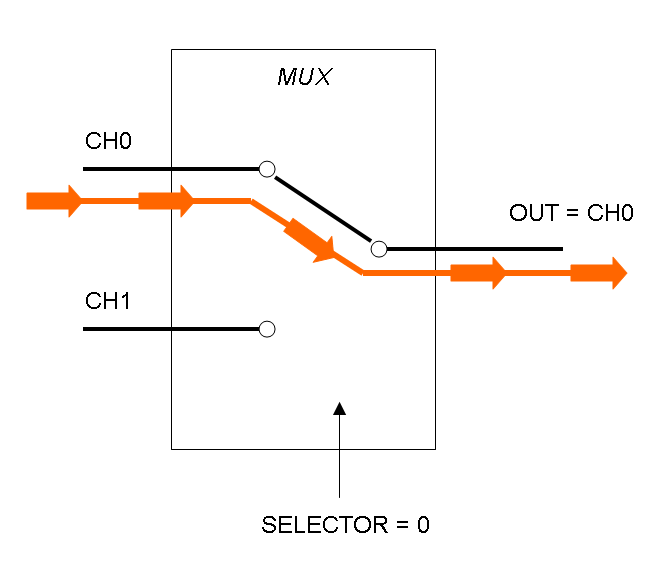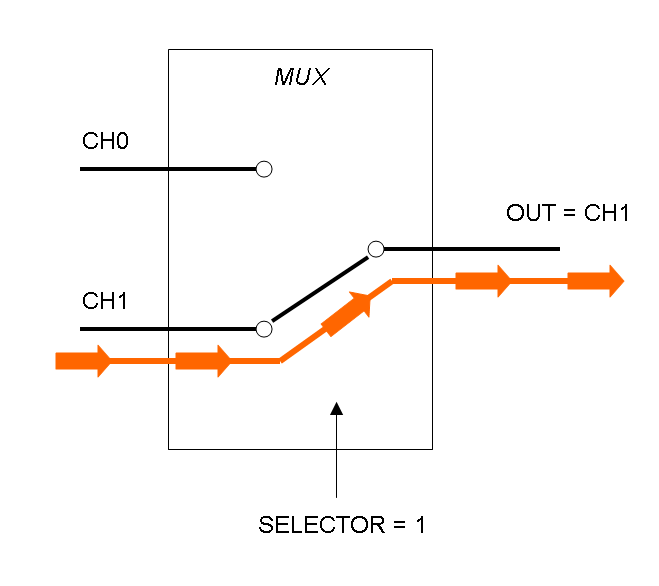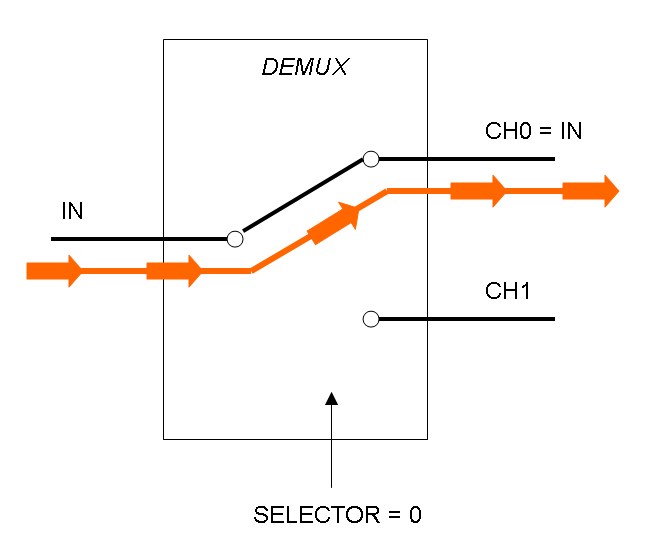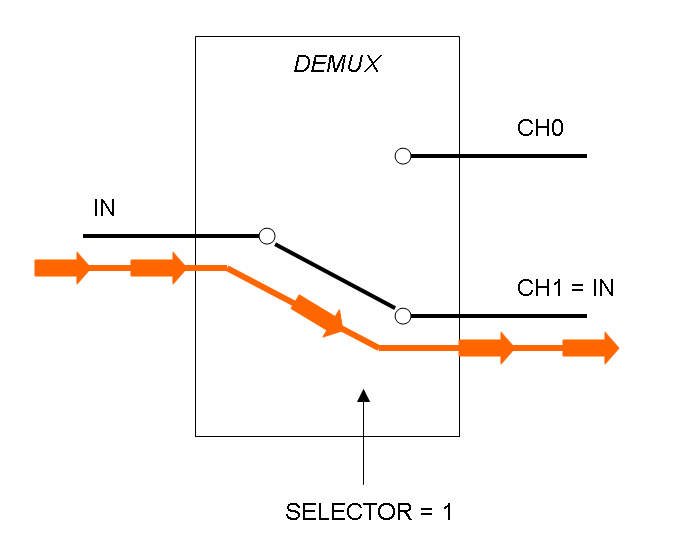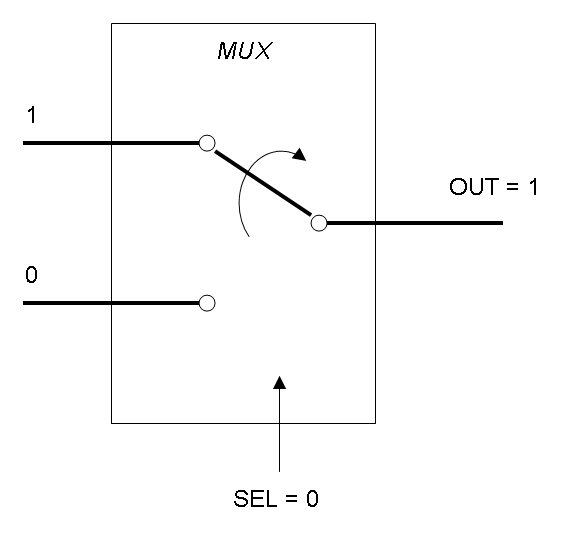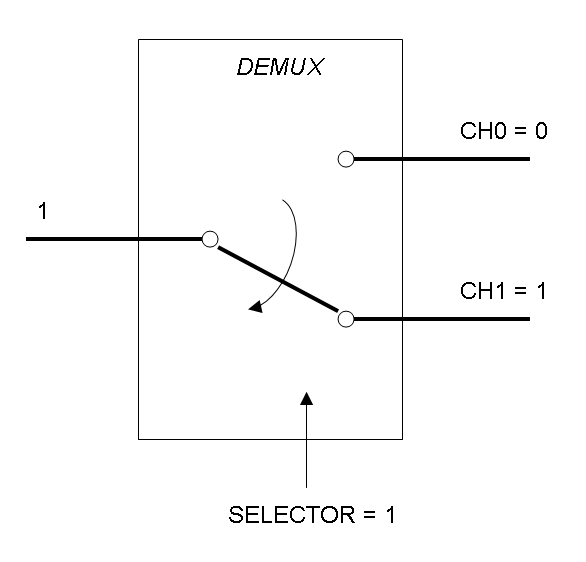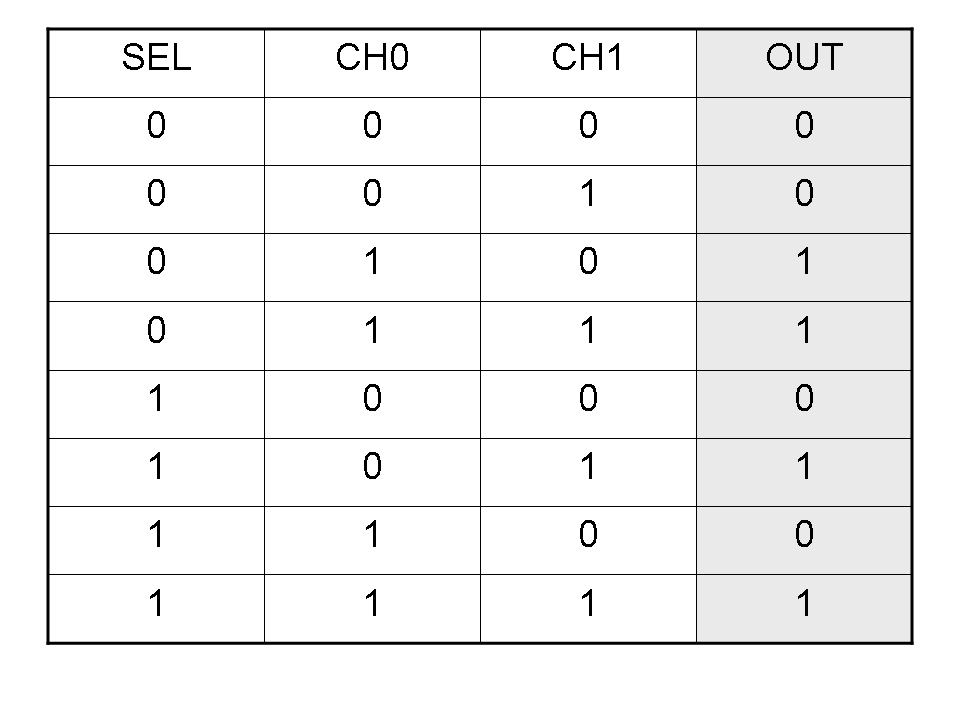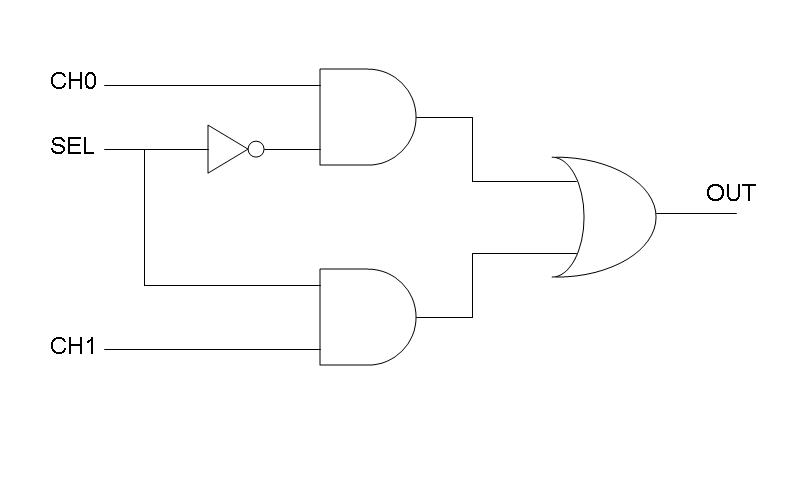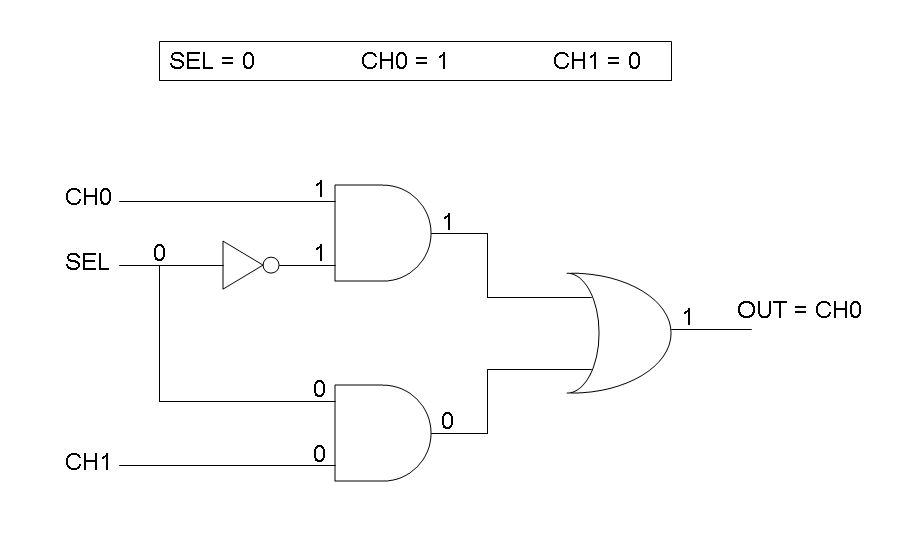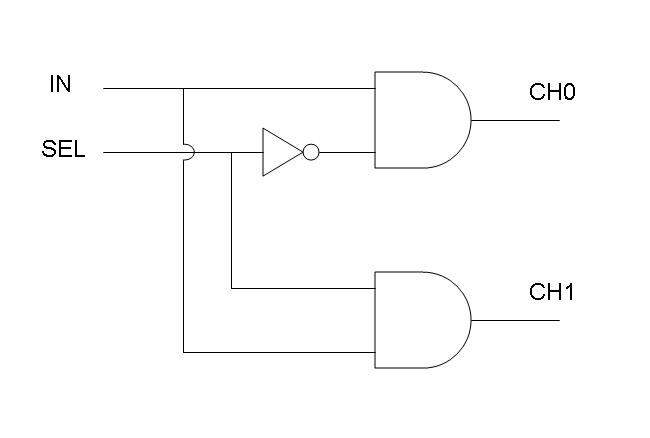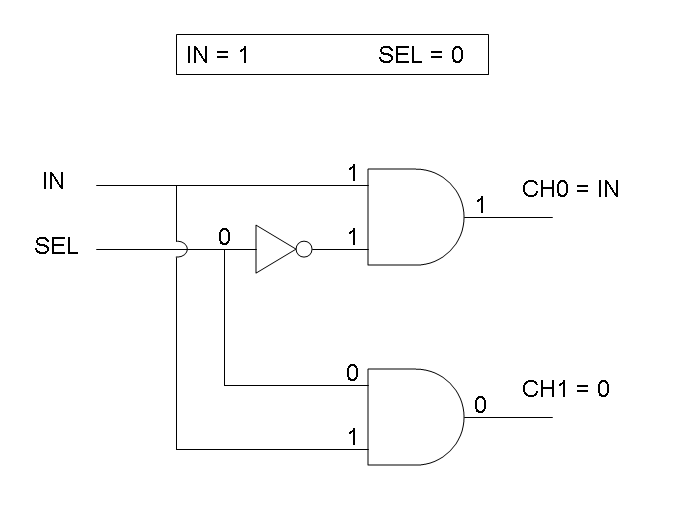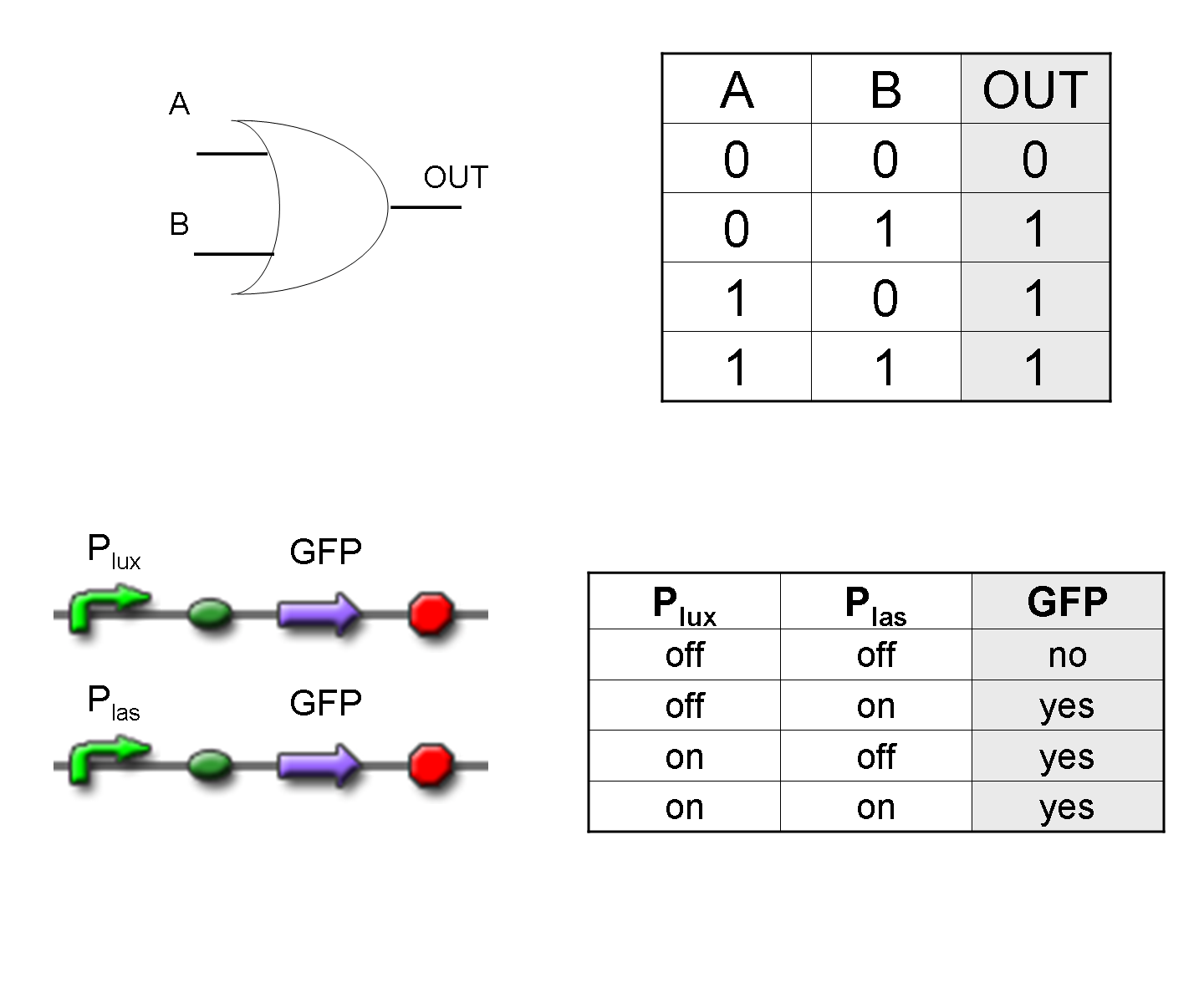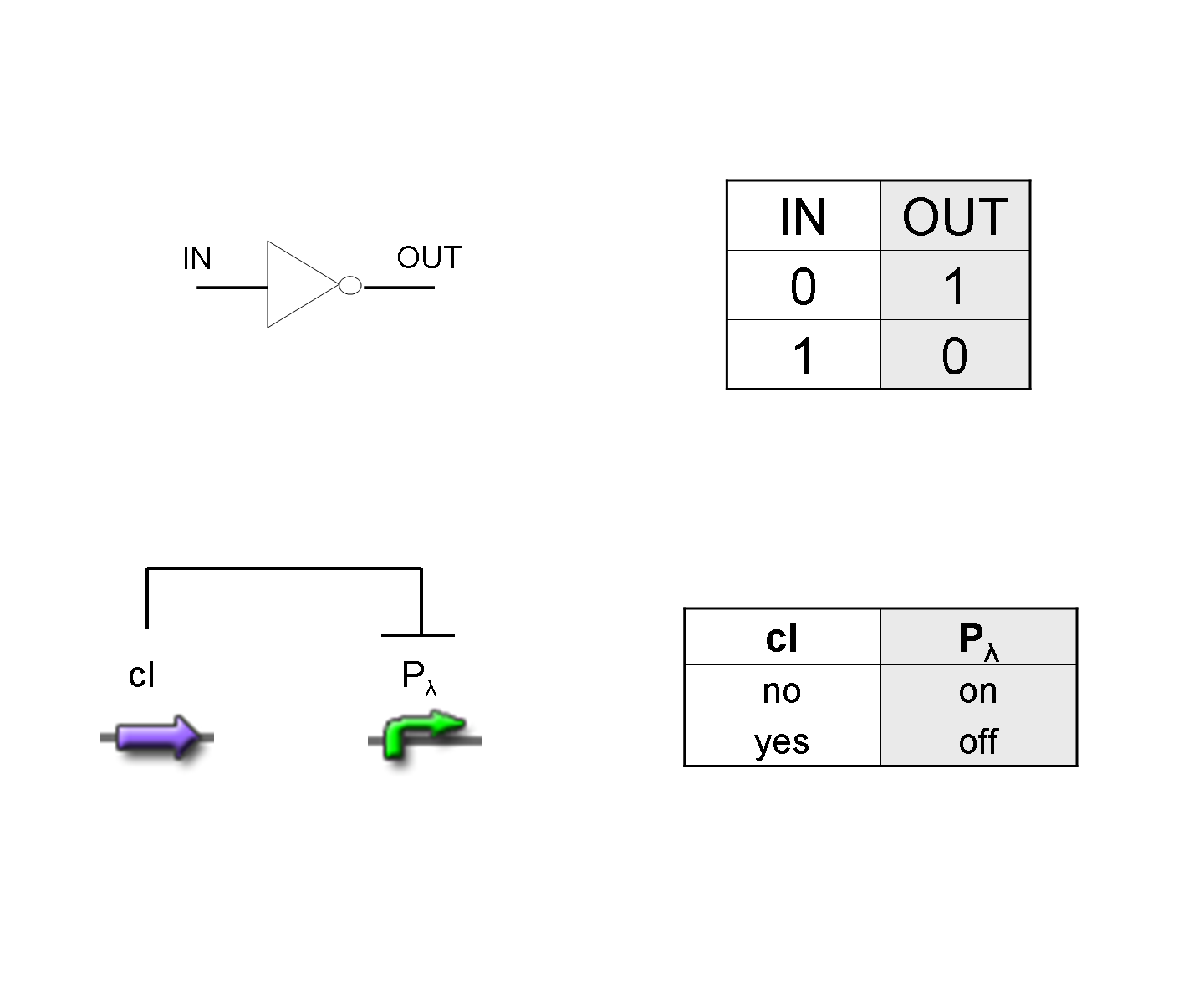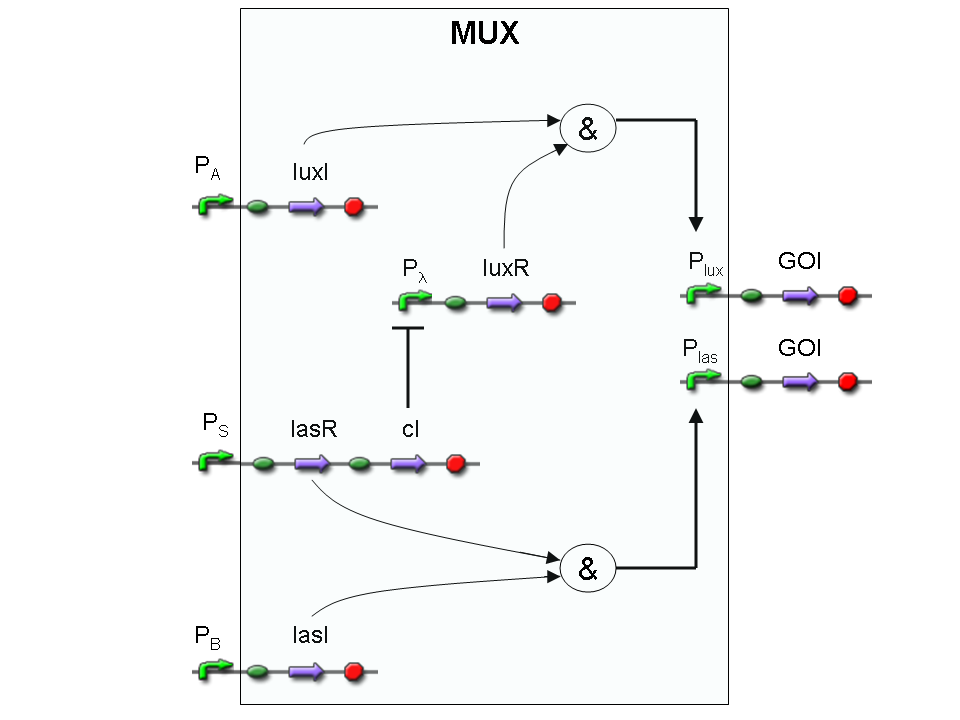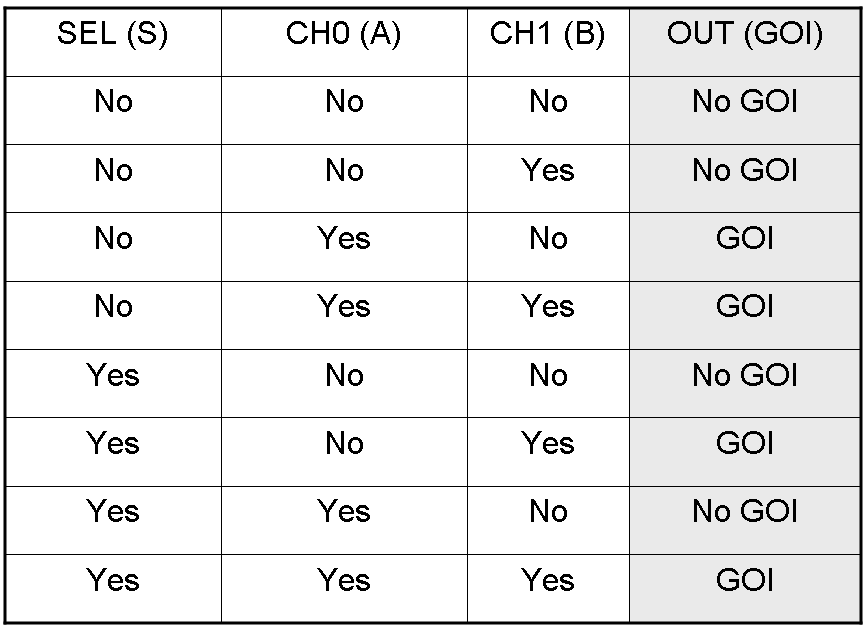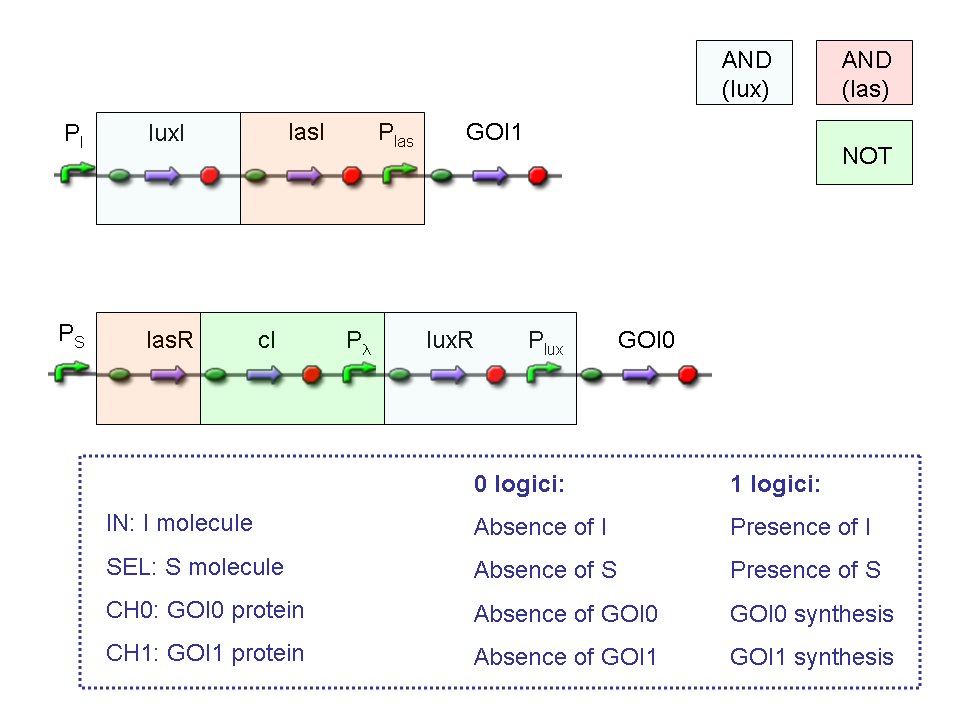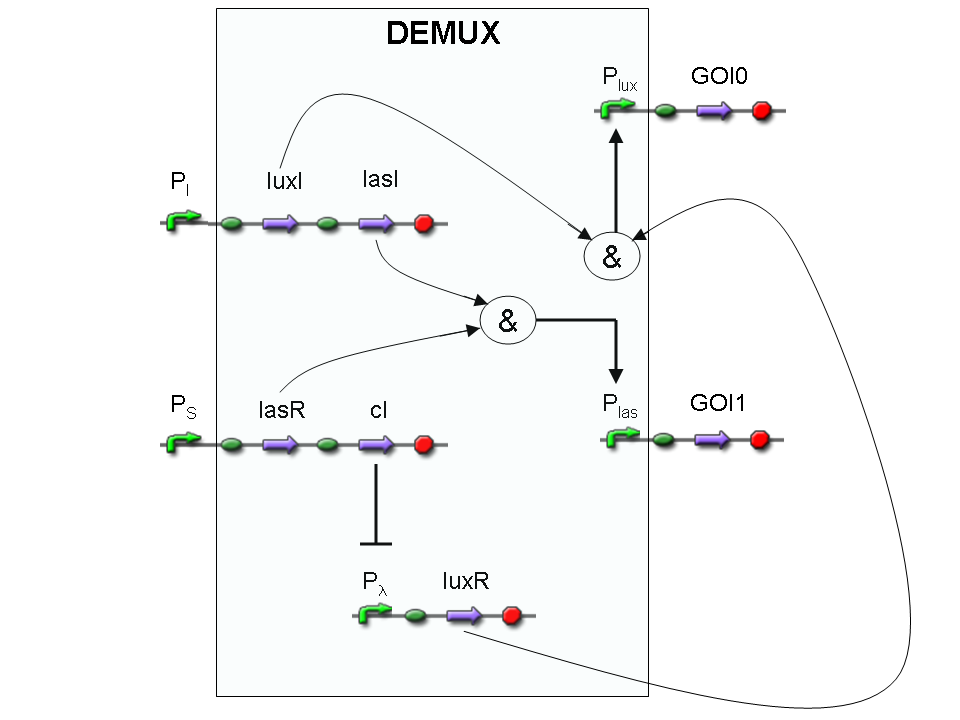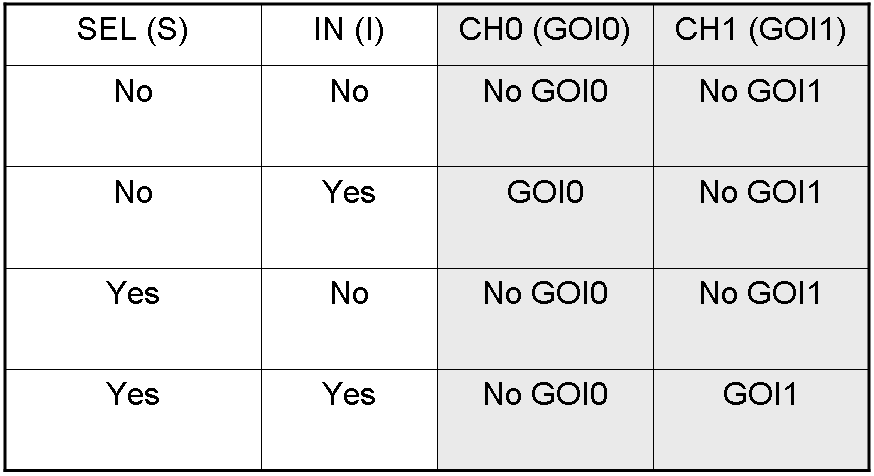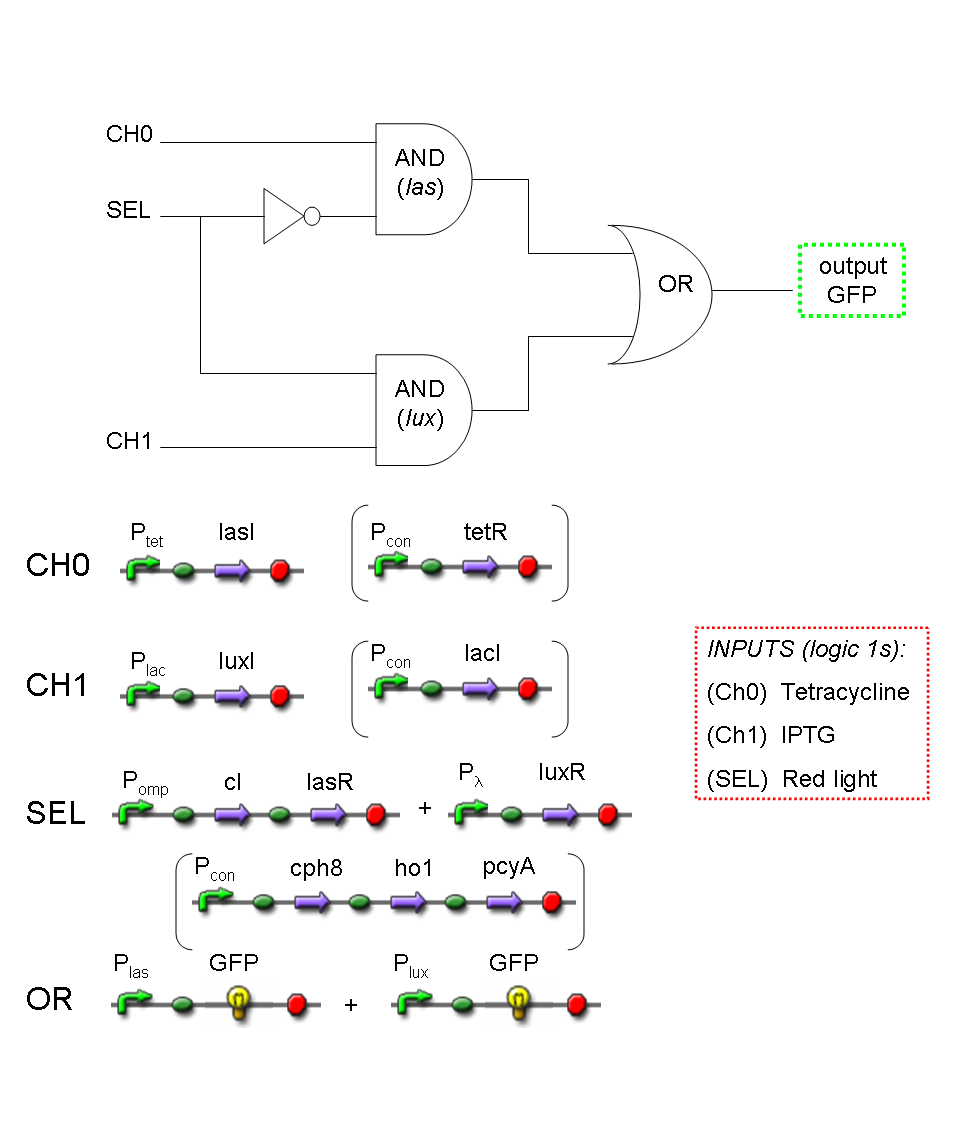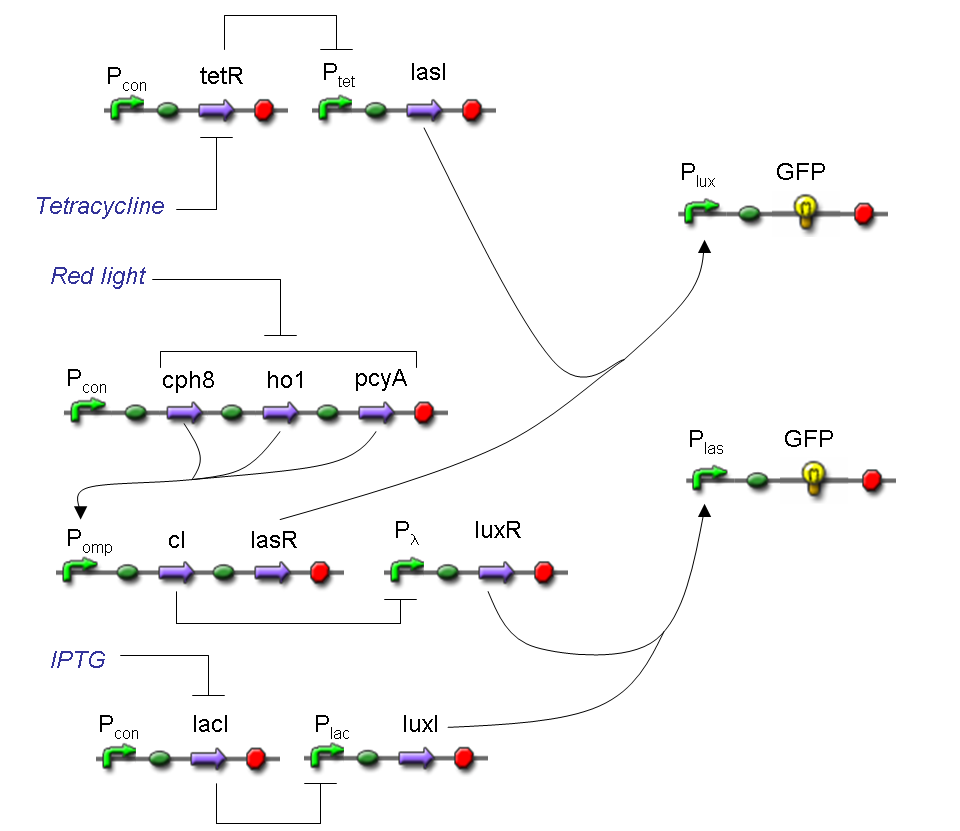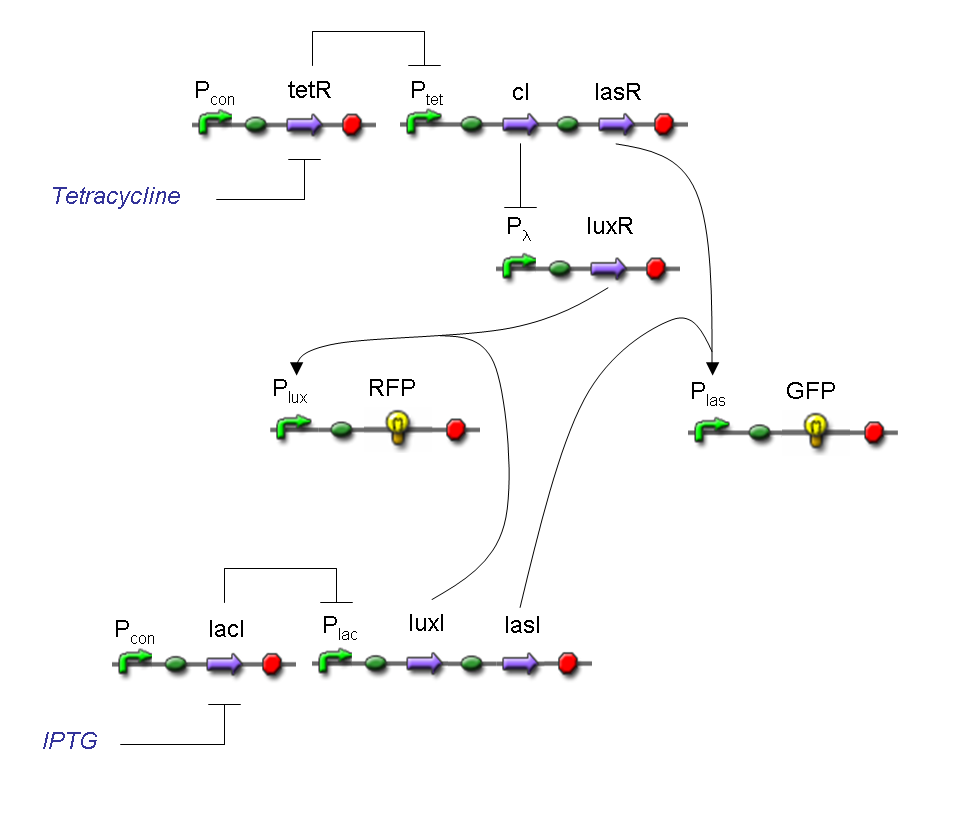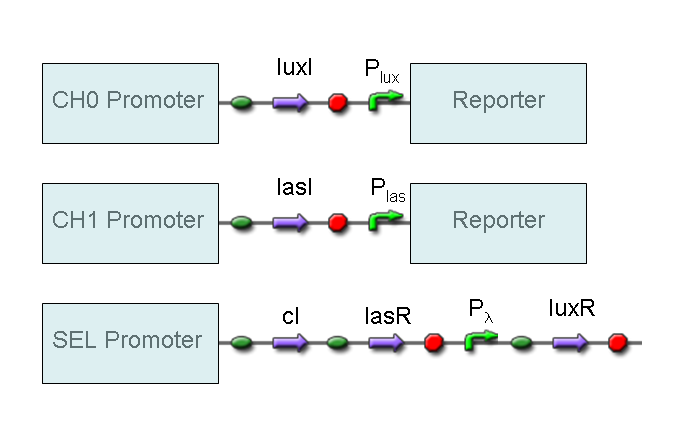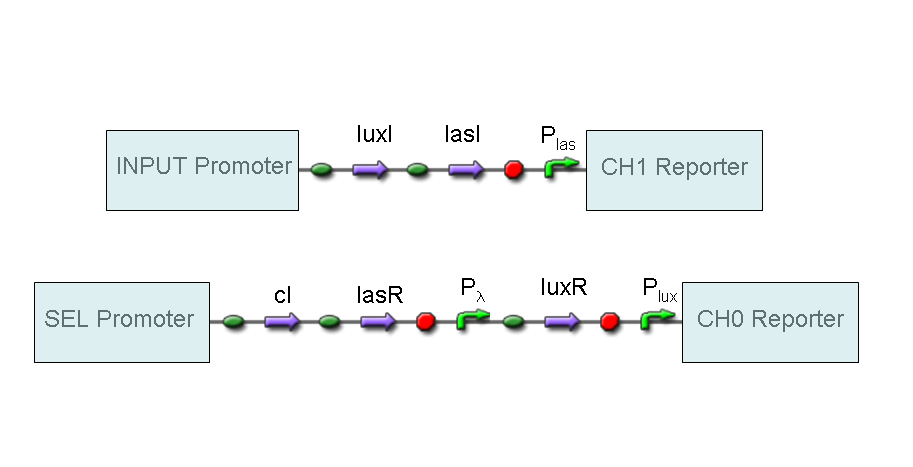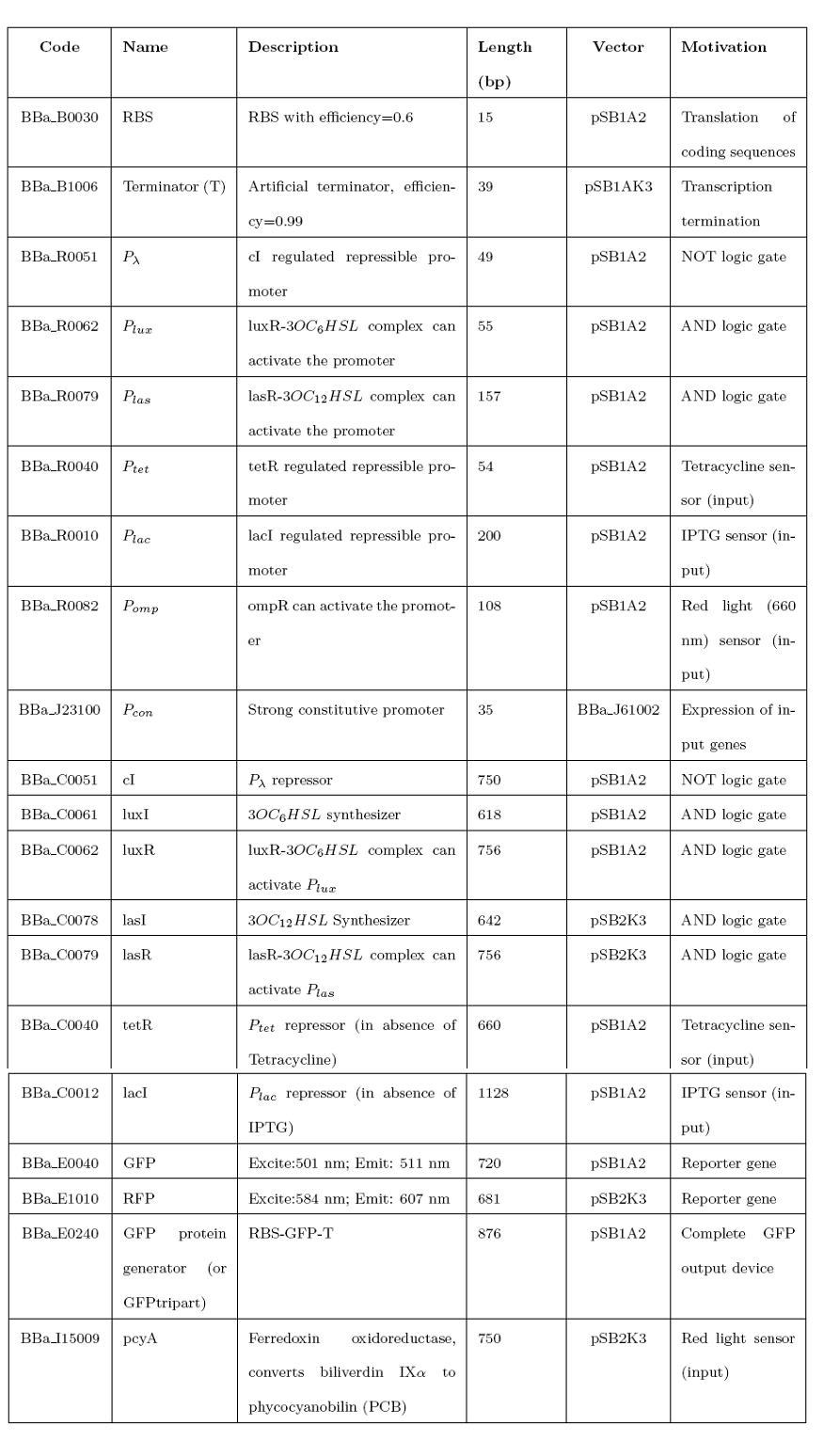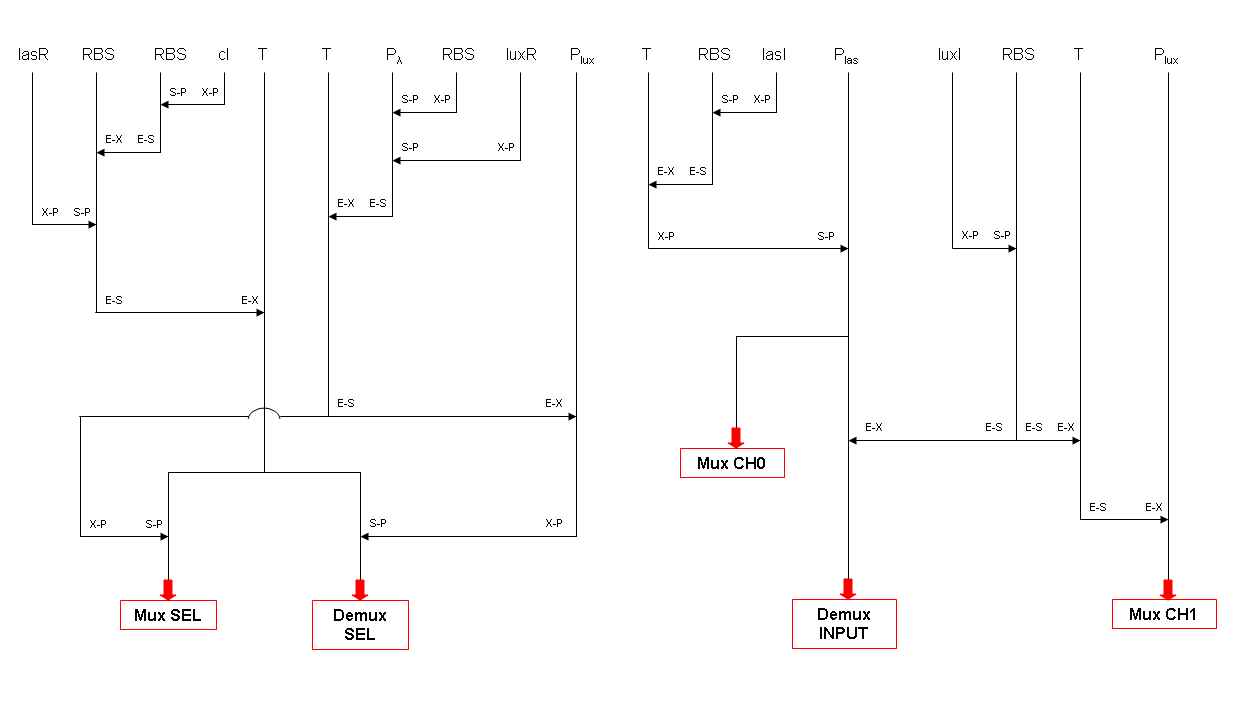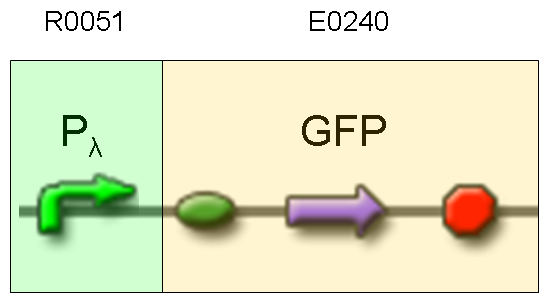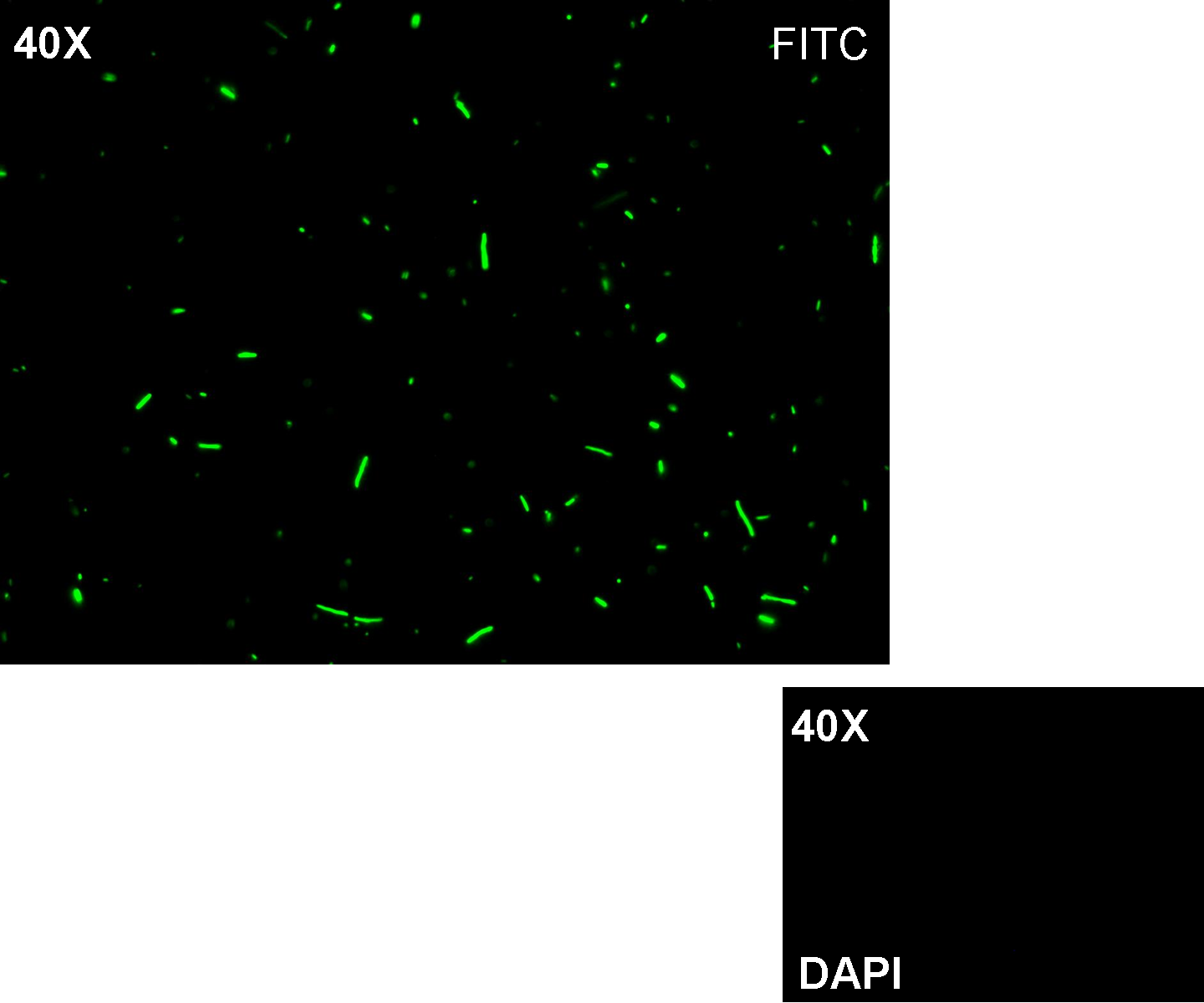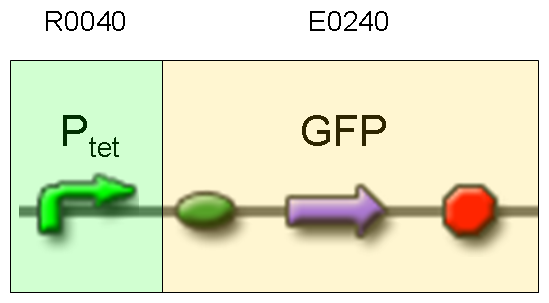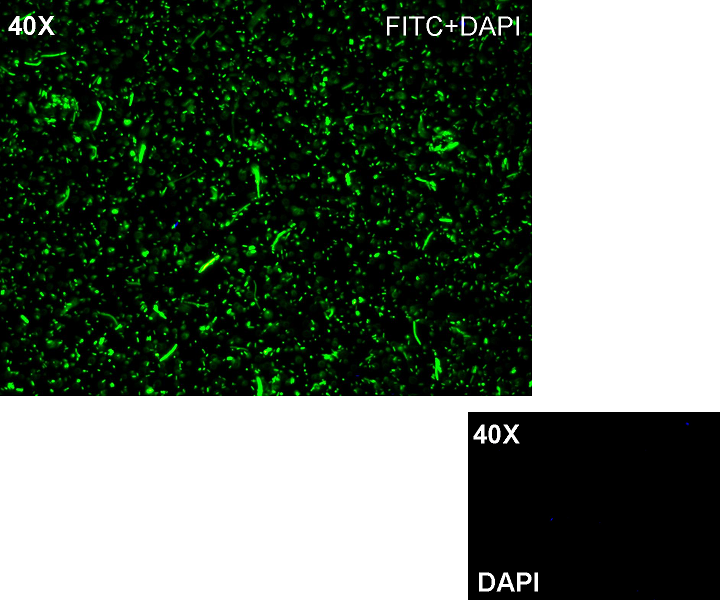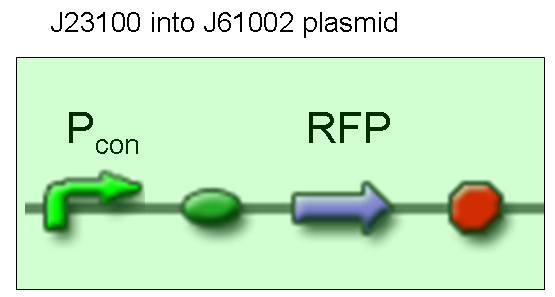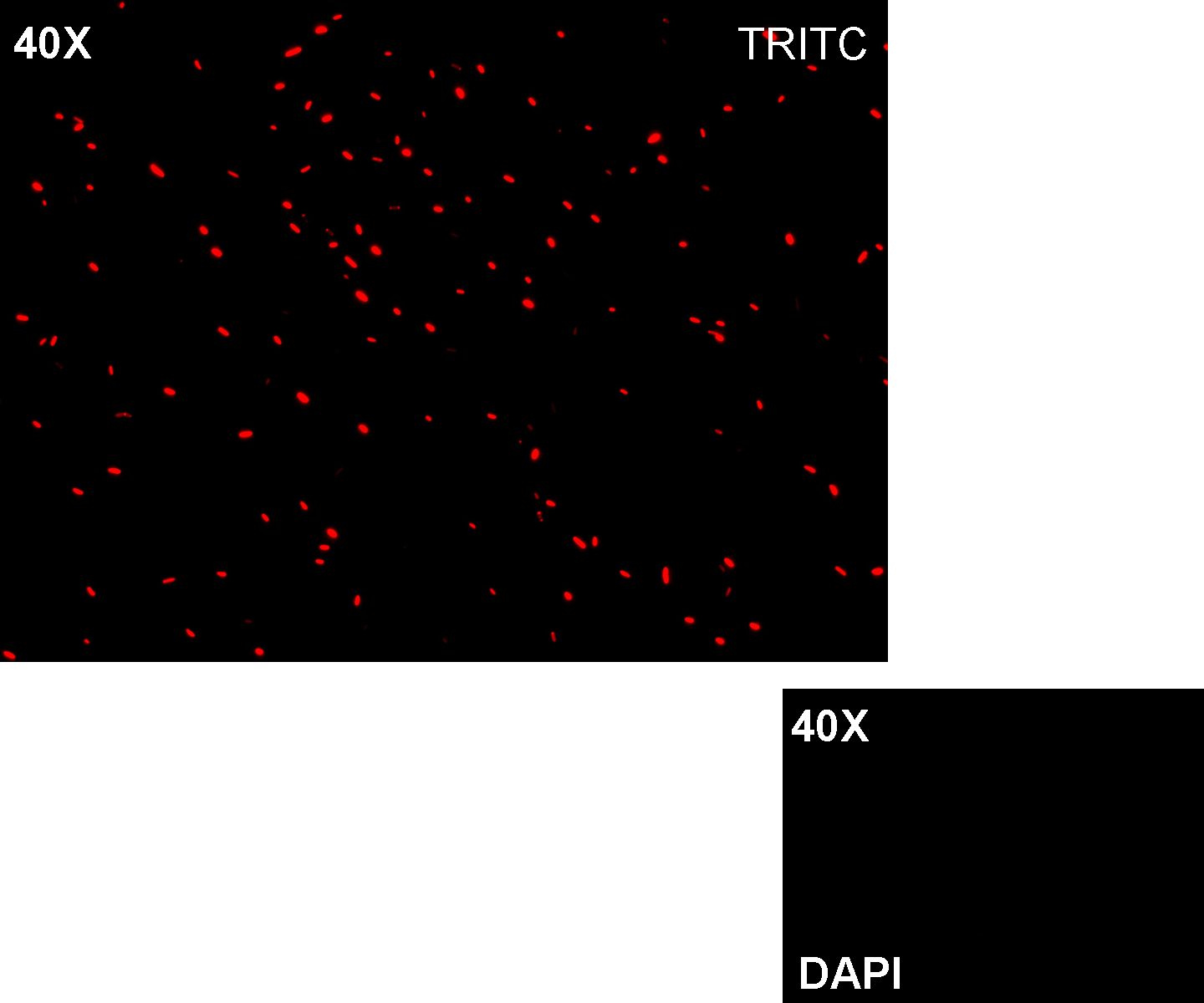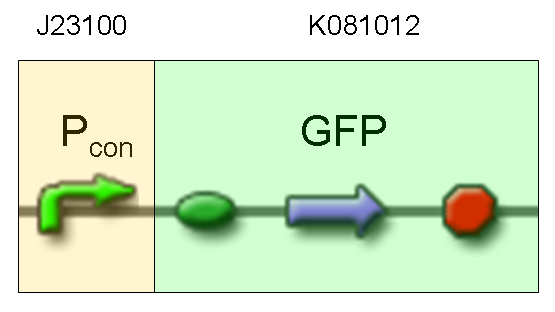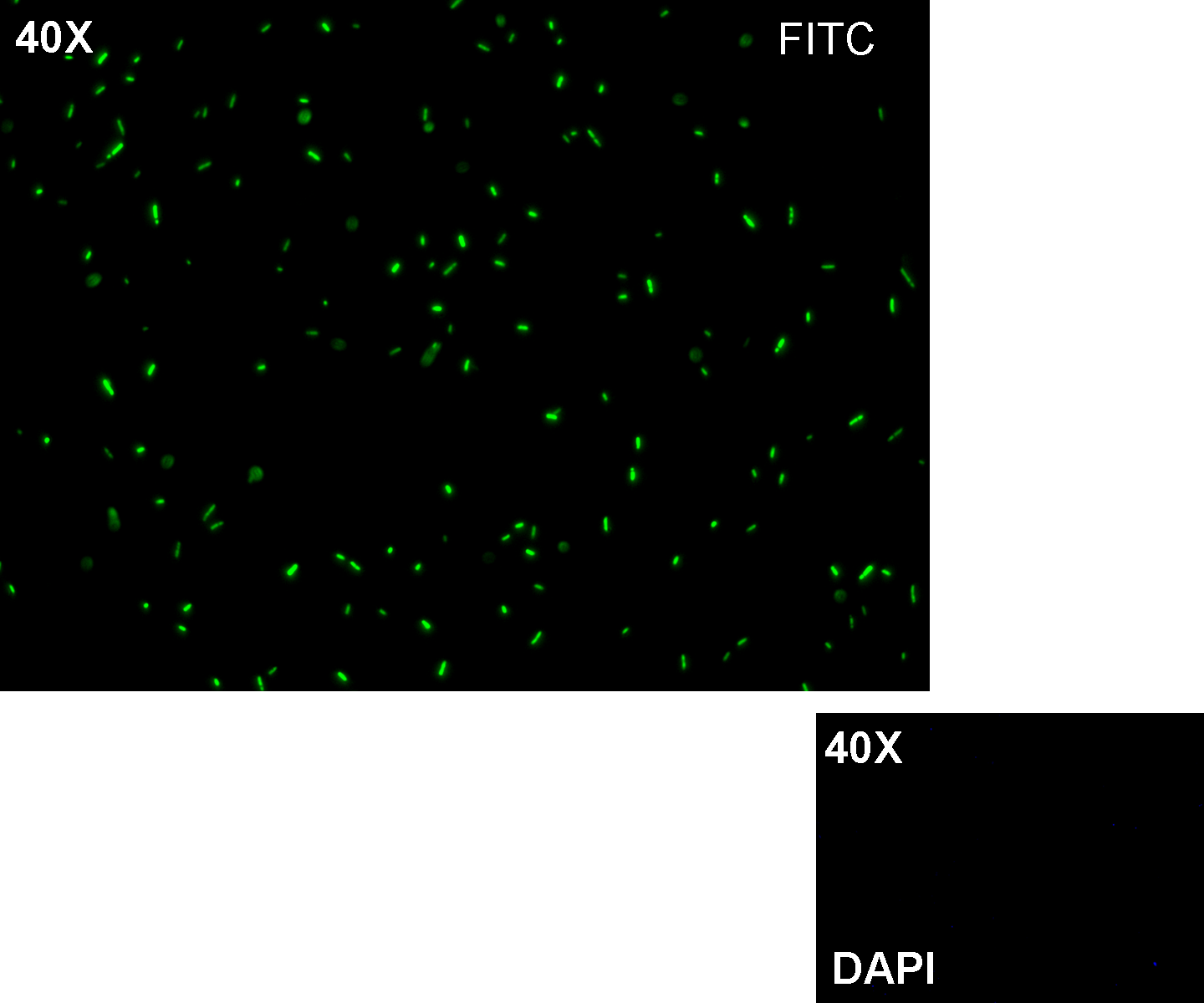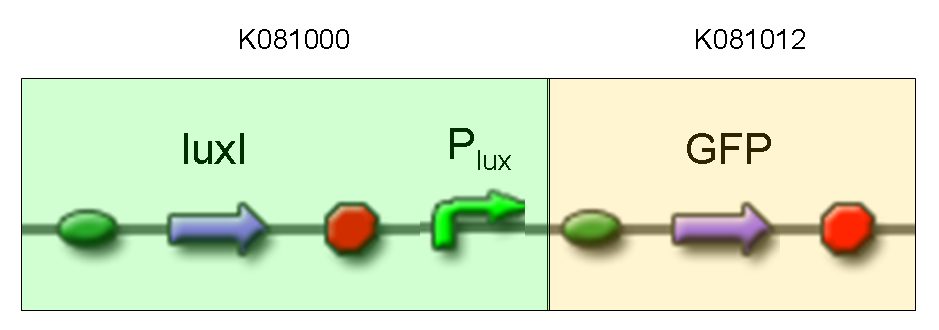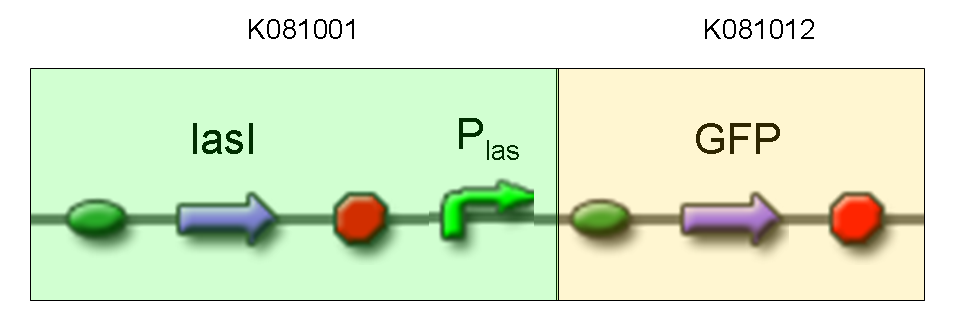Team:UNIPV-Pavia/Project
From 2008.igem.org
| Line 320: | Line 320: | ||
|[[Image:pv_test1.png|thumb|600px|left|GFP protein generator under Plambda]] | |[[Image:pv_test1.png|thumb|600px|left|GFP protein generator under Plambda]] | ||
|} | |} | ||
| - | '''Description:''' | + | '''Description:''' we assembled an available GFP protein generator (E0240) under Plambda promoter, keeping pSB1A2 as the scaffold vector. |
<br> | <br> | ||
| - | '''Motivation:''' | + | '''Motivation:''' cI protein was not present, so Plambda should work like a constitutive promoter. A reporter gene downstream of this promoter allows us to validate Plambda costitutive activity. That can be very useful to validate our NOT logic gate. |
<br> | <br> | ||
| - | ''' | + | '''Methods:''' after ligation reaction of R0051 and E0240, we transformed ligation product using Invitrogen TOP10 cells and plated transformed bacteria. Then we watched the plate on the transluminator to check if positive transformants glowed under UV rays. We also picked up a fluorescent colony with a tip and infected 1 ml of LB + Amp. After 3 hours at 37°C, 220 rpm we watched 50 ul of the culture at microscope through FITC channel. |
<br> | <br> | ||
| - | '''Comments:''' | + | '''Results:''' positive transformants glowed under UV rays and green fluorescent cells could be observed at microscope (see figure). |
| + | {|align="center" | ||
| + | |[[Image:pv_fig_test1.png|thumb|600px|left|TOP10 cells at microscope]] | ||
| + | |} | ||
| + | <br> | ||
| + | '''Comments:''' this experiment confirmed that GFP was expressed in positive transformants, so Plambda activity was qualitatively validated. | ||
<br> | <br> | ||
| Line 334: | Line 339: | ||
|[[Image:pv_test2.png|thumb|600px|left|GFP protein generator under Ptet]] | |[[Image:pv_test2.png|thumb|600px|left|GFP protein generator under Ptet]] | ||
|} | |} | ||
| - | '''Description:''' | + | '''Description:''' we assembled E0240 under Ptet promoter, keeping pSB1A2 as the scaffold vector. |
<br> | <br> | ||
| - | '''Motivation:''' | + | '''Motivation:''' tetR protein was not present, so Ptet should work like a constitutive promoter. A reporter gene downstream of this promoter allows us to validate Ptet costitutive activity. Ptet is useful for specific input building. |
<br> | <br> | ||
| - | ''' | + | '''Methods:''' after ligation reaction of R0040 and E0240, we transformed ligation product using Invitrogen TOP10 cells and plated transformed bacteria. Then we watched the plate on the transluminator to check if positive transformants glowed under UV rays. We also picked up a fluorescent colony with a tip and infected 1 ml of LB + Amp. After 3 hours at 37°C, 220 rpm we watched 50 ul of the culture at microscope through FITC channel. |
<br> | <br> | ||
| - | '''Comments:''' | + | '''Results:''' positive transformants glowed under UV rays and green fluorescent cells could be observed at microscope (see figure). |
| + | {|align="center" | ||
| + | |[[Image:pv_fig_test2.png|thumb|600px|left|TOP10 cells at microscope]] | ||
| + | |} | ||
| + | <br> | ||
| + | '''Comments:''' this experiment confirmed that GFP was expressed in positive transformants, so Ptet activity was qualitatively validated. | ||
<br> | <br> | ||
| Line 348: | Line 358: | ||
|[[Image:pv_test3.png|thumb|600px|left|RFP protein generator under constitutive promoter]] | |[[Image:pv_test3.png|thumb|600px|left|RFP protein generator under constitutive promoter]] | ||
|} | |} | ||
| - | '''Description:''' | + | '''Description:''' we didn't perform any assembly for this experiment, because the promoter we wanted to test was contained into BBa_J61002 vector, which places a RFP protein generator between SpeI and PstI restriction sites. |
<br> | <br> | ||
| - | '''Motivation:''' | + | '''Motivation:''' J23100, which we call Pcon, should have a strong constitutive activity. A reporter gene downstream of this promoter allows us to validate this activity. Pcon is useful to build our inputs because some sensors like IPTG and Tetracycline sensors need the constitutive production of specific proteins, in this case lacI and tetR respectively. |
<br> | <br> | ||
| - | ''' | + | '''Methods''' we transformed J23100 using Invitrogen TOP10 and plated transformed bacteria. We expected to observe red fluorescence (using transluminator) in all the colonies. We also picked up a colony with a tip and infected 1 ml of LB + Amp. After 3 hours at 37°C, 220 rpm we watched 50 ul of the culture at microscope through TRITC channel. |
<br> | <br> | ||
| - | '''Comments:''' | + | '''Results:''' all the grown colonies glowed under UV rays and red fluorescent cells could be observed at microscope (see figure). |
| + | {|align="center" | ||
| + | |[[Image:pv_fig_test3.png|thumb|600px|left|TOP10 cells at microscope]] | ||
| + | |} | ||
| + | <br> | ||
| + | '''Comments:''' this experiment confirmed that RFP was expressed in transformed bacteria, so Pcon functionality was qualitatively validated. | ||
<br> | <br> | ||
| Line 360: | Line 375: | ||
<br> | <br> | ||
{|align="center" | {|align="center" | ||
| - | |[[Image:pv_test4.png|thumb|600px|left|GFP protein generator under Plux]] | + | |[[Image:pv_test4.png|thumb|600px|left|Our GFP protein generator (K081012) under a constitutive promoter]] |
| + | |} | ||
| + | '''Description:''' we assembled a constitutive promoter family member (J23100) upstream of K081012, a GFP protein generator we built. We decided to excide J23100 from its plasmid (E-S) and to open K081012 plasmid (pSB1AK3) (E-X). | ||
| + | <br> | ||
| + | '''Motivation:''' we already validated qualitatively J23100 constitutive activity, so this promoter can be used to test the GFP protein generator we built. We wanted to check if K081012 actually generates GFP. | ||
| + | <br> | ||
| + | '''Methods''' after ligation reaction of J23100 and K081012, we transformed ligation product using Invitrogen TOP10 cells and plated transformed bacteria. Then we watched the plate on the transluminator to check if positive transformants glowed under UV rays. We also picked up a fluorescent colony with a tip and infected 1 ml of LB + Amp. After 3 hours at 37°C, 220 rpm we watched 50 ul of the culture at microscope through FITC channel. | ||
| + | <br> | ||
| + | '''Results:''' positive transformants glowed under UV rays (see figure) and green fluorescent cells could be observed at microscope (see figure). | ||
| + | {|align="center" | ||
| + | |[[Image:pv_fig_test4.png|thumb|600px|left|TOP10 cells at microscope]] | ||
| + | |} | ||
| + | <br> | ||
| + | '''Comments:''' this experiment confirmed that our GFP protein generator actually generates GFP. | ||
| + | <br> | ||
| + | |||
| + | *'''TEST 6''' | ||
| + | <br> | ||
| + | {|align="center" | ||
| + | |[[Image:pv_test6.png|thumb|600px|left|GFP protein generator under Plux]] | ||
|} | |} | ||
'''Description:''' | '''Description:''' | ||
| Line 371: | Line 405: | ||
<br> | <br> | ||
| - | *'''TEST | + | *'''TEST 7''' |
<br> | <br> | ||
{|align="center" | {|align="center" | ||
| - | |[[Image: | + | |[[Image:pv_test7.png|thumb|600px|left|GFP protein generator under Plas]] |
|} | |} | ||
'''Description:''' | '''Description:''' | ||
| Line 385: | Line 419: | ||
<br> | <br> | ||
| - | *'''TEST | + | *'''TEST 8''' |
<br> | <br> | ||
{|align="center" | {|align="center" | ||
| - | |[[Image: | + | |[[Image:pv_test8.png|thumb|600px|left|GFP protein generator under Plux and constitutive expression of luxI and luxR]] |
|} | |} | ||
'''Description:''' | '''Description:''' | ||
| Line 399: | Line 433: | ||
<br> | <br> | ||
| - | *'''TEST | + | *'''TEST 9''' |
<br> | <br> | ||
{|align="center" | {|align="center" | ||
| - | |[[Image: | + | |[[Image:pv_test9.png|thumb|600px|left|GFP protein generator under Plux and constitutive expression of luxR]] |
|} | |} | ||
'''Description:''' | '''Description:''' | ||
| Line 413: | Line 447: | ||
<br> | <br> | ||
| - | *'''TEST | + | *'''TEST 10''' |
<br> | <br> | ||
{|align="center" | {|align="center" | ||
| - | |[[Image: | + | |[[Image:pv_test10.png|thumb|600px|left|RFP protein generator under Plux and constitutive expression of luxR]] |
|} | |} | ||
'''Description:''' | '''Description:''' | ||
| Line 427: | Line 461: | ||
<br> | <br> | ||
| - | *'''TEST | + | *'''TEST 11''' |
<br> | <br> | ||
{|align="center" | {|align="center" | ||
| - | |[[Image: | + | |[[Image:pv_test11.png|thumb|600px|left|GFP protein generator under constitutive promoter]] |
|} | |} | ||
'''Description:''' | '''Description:''' | ||
| Line 441: | Line 475: | ||
<br> | <br> | ||
| - | *'''TEST | + | *'''TEST 12''' |
<br> | <br> | ||
{|align="center" | {|align="center" | ||
| - | |[[Image: | + | |[[Image:pv_test12.png|thumb|600px|left|RFP protein generator under constitutive promoter]] |
|} | |} | ||
'''Description:''' | '''Description:''' | ||
Revision as of 09:04, 23 October 2008
Contents |
Overall project
We are trying to mimic Multiplexer (Mux) and Demultiplexer (Demux) logic functions in E. coli.
In the following paragraphs project details will be described from both digital electronic and genetic points of view.
Electronic Implementation
What kind of components are Mux and Demux?
Mux is a component which conveys one of the two input channels values into a single output channel. The choice of the input channel is made by a selector.
Demux is a component which conveys the only input channel value into one of the two output channels. The choice of the output channel is made by a selector.
The following pictures show data flow in Mux and Demux:
What kind of signals do we process?
In this project we consider Boolean logic signals, thus every input/output value can assume only the values 0 and 1. A function that processes Boolean values is called logic function.
Mux and Demux can be considered by now as black boxes which implement a logic function that can process input signals to output signals. Here you can see examples of Boolean data flow in Mux and Demux:
In the following documentation we will see what is inside these black boxes.
How can we formalize Mux and Demux logic behavior?
Logic functions can be formalized writing a truth table; a truth table is a mathematical table in which every row represents a combination of input values and its respective output values. The table has to be filled with every input combination.
Here you can see Mux and Demux truth tables (output columns are gray):
Building a logic circuit from a truth table
Our goal in this section is to project two logic gates networks which behave like Mux and Demux truth tables. A very useful tool to transform a truth table into a logic network is Karnaugh map.
It is possible to read about Karnaugh maps at: [http://en.wikipedia.org/wiki/Karnaugh_map]
Following Karnaugh maps method, we can write these two logic networks for Mux and Demux:
Genetic Implementation
Our goal is to mimic Mux and Demux logic networks in a biological device, such as E. coli. To perform this, we use protein/DNA and protein/protein interactions to build up biological logic gates.
Mux and Demux logic circuits are composed by three fundamental logic gates, AND, OR, NOT: in the next paragraphs genetic implementation of these logic gates will be provided.
AND
To mimic an AND gate, we need a biological function, such as a promoter activation, which is directly turned on by the interaction between two upstream genes. In our synthetic devices, we use the luxR/luxI system: luxR can activate Plux promoter only upon 3-oxo-hexanoyl-homoserine lactone (HSL) binding; luxI generates HSL; so, only the contemporary expression of LuxR and luxI proteins can activate the downstream Plux-dependent gene expression. Another AND gate we use is the lasR/lasI system, which works in a very similar way but through another chemical intermediate, N-(3-oxododecanoyl) homoserine lactone (PAI-1).
OR
To mimic an OR gate in Mux, we need a biological function which can be activated alternatively by two independent upstream signals or by both. Thus, we combine the outputs of the upstream AND gates to assemble directly an OR reporter function, by simply repeating the reporter gene (GFP) under two different promoters (Plux and Plas). It’s sufficient to activate one of the two promoters (or both) to recover the GFP signal from engineered bacteria. There should not be an over-expression problem for GFP, in fact, in Mux device, only one promoter can be active, either Plux or Plas. Here we considered GFP output, but OR device can be generalized for every output gene.
NOT
To mimic a NOT gate, we need an efficient and regulated repressor of a specific downstream promoter: in this case, we choose cI repression on Plambda, which should be specific and, upon cI inactivation, quick and efficient.
According to what above stated, genetic implementation of Mux and Demux can be obtained connecting these basic logic gates and can be summarized in this way:
Genetic Mux
Let PA, PB and PS be three generic promoters that can be ACTIVATED respectively by the three exogenous molecules "A", "B" and "S". A genetic Mux with inputs "A" (CH0) and "B" (CH1), selector "S" and the generic protein GOI as output, can be implemented by the following gene network:
We want to supply a device that can be generalized to detect every kind of input and to express every kind of genes as output. So, input promoters and output protein generators are not part of the genetic Mux we want to build up. In this way, a hypothetical user can re-use our device assembling the desired input and output elements.
Note that the output genes are two, but, as explained in "OR" section, if the genes are identical, we can say that there is only one output; in fact, the real output is a protein synthesis and so it is not important which of the two identical genes is expressed.
However, it is possible to assemble two different genes downstream of Plux and Plas, for example two reporters. In this way, debugging process becomes easy, because we can discriminate lux system and las system activities.
Here we report the truth table of this network:
Now we report two examples of genetic Mux behavior, in response to generic inputs.
Genetic Mux behavior - Example 1
According to Mux truth table, if "A" is not present and "B" and "S" are present, we expect to have GOI synthesis.
"A" molecule is not present, so PA promoter is not active and luxI gene is not expressed.
"B" molecule is present, so PB promoter is active and lasI gene is expressed.
"S" molecule is present, so PS promoter is active and lasR and cI genes are expressed.
cI protein represses transcription of the gene downstream of Plambda promoter, which is luxR.
lasI protein can synthesize 3-OC12-HSL. This molecule activates transcription factor lasR, which can activate Plas promoter. So, the copy of GOI gene under Plas regulation can be expressed.
The other copy of GOI gene, which is under Plux promoter regulation, is not expressed. In fact Plux is not active, because both luxI and luxR proteins are not present.
Only one of the two GOI genes is expressed, but this is sufficient to synthesize the output protein GOI.
Genetic Mux behavior - Example 2
We expect to have no GOI synthesis in response to this input combination.
"A" molecule is not present, so PA promoter is not active and luxI gene is not expressed.
"B" molecule is present, so PB promoter is active and lasI gene is expressed.
"S" molecule is not present, so PS promoter can't transcribe cI and lasR genes.
cI protein is not present, so Plambda promoter can transcribe luxR gene.
None of the two logic AND systems is active, because lux system lacks of luxI and las system lacks of lasR. So, Plux and Plas promoters are unactive and can't express GOI genes. For this reason, GOI protein is not synthesized.
These two examples show how "S" molecule can select the input to be conveyed into the single output channel: in fact its presence allows lasR expression and represses luxR expression, while "S" absence represses lasR expression and allows luxR expression.
Genetic Demux
Let PI and PS be two generic promoters that can be ACTIVATED respectively by the two exogenous molecules "I" and "S". A genetic Demux with input "I", selector "S" and the generic proteins GOI0 and GOI1 as outputs (OUT0 and OUT1 respectively), can be implemented by the following gene network:
As described for genetic Mux, we want to supply a device that can be generalized to detect every kind of inputs and to express every kind of genes as output. So, input promoters and output protein generators are not part of the genetic Demux. In this way, a hypothetical user can re-use our device assembling the desired input and output elements.
Here we report the truth table of this network:
Now we report two examples of genetic Demux behavior, in response to generic inputs.
Genetic Demux behavior - Example 1
According to Demux truth table, if "I" molecule is present and "S" molecule is absent, we expect to have GOI0 protein synthesis and no GOI1 protein synthesis.
"I" is present, so PI promoter is active and luxI and lasI genes are expressed.
"S" is not present, so PS promoter can't transcribe lasR and cI genes.
cI protein is not present, so Plambda promoter is not inhibited and luxR gene is expressed.
luxI protein can synthesize 3-OC6-HSL lactone. This molecule activates luxR transcription factor which can activate Plux promoter. In this way, GOI0 gene, which is under Plux regulation, is expressed.
On the other hand, lasI protein can synthesize 3-OC12-HSL, but lasR transcription factor is not present and so Plas promoter cannot be activated. In this way, GOI1 gene, which is under Plas regulation, is not expressed.
So, we have GOI0 protein synthesis and no GOI1 protein synthesis.
Genetic Demux behavior - Example 2
We expect to have GOI1 synthesis and no GOI0 synthesis in response to this input combination.
"I" is present, so PI promoter is active and luxI and lasI genes are expressed.
"S" is present, so PS promoter lasR and cI genes are expressed.
cI protein is present, so Plambda promoter is inhibited and luxR gene is not expressed.
lasI protein can synthesize 3-OC12-HSL lactone. This molecule activates lasR transcription factor which can activate Plas promoter. In this way, GOI1 gene, which is under Plas regulation, is expressed.
On the other hand, luxI protein can synthesize 3-OC6-HSL, but luxR transcription factor is not present and so Plux promoter cannot be activated. In this way, GOI0 gene, which is under Plux regulation, is not expressed.
So, we have GOI1 protein synthesis and no GOI0 protein synthesis.
A complete genetic Mux
In this section a complete Mux gene network is described.
We want to build up a device in which Channel 0, Channel 1 and Selector are respectively sensitive to Tetracycline, IPTG and red light. The presence of each input corresponds to logic 1.
We chose green fluorescence as Mux output: expression of GFP corresponds to logic 1, while absence of fluorescence corresponds to logic 0.
Tetracycline and IPTG can be considered as "A" and "B" molecules, introduced in "Genetic Mux" section, because both Tetracycline and IPTG are indirect ACTIVATORS of Ptet and Plac promoters respectively.
On the other hand, red light is quite different from "S" molecule, because red light is an indirect REPRESSOR of Pomp promoter and not an activator as required by the original schema. For this reason, if we want a device in which the presence of Tetracycline, IPTG and red light correspond to logic 1, red light input should be inverted. The simplest way to do this, is to cross-exchange the two input channels. So, Tetracycline sensor (CH0) has to be assembled to las system and IPTG sensor (CH1) has to be assembled to lux system.
Complete genetic Mux - Example
According to Mux truth table, if SEL=0, CH0=1, CH1=0, output channel must be logic 1. Red light is not present, so it can't dephosphorylate cph8-ho1-pcyA complex, which is constitutively expressed. cph8-ho1-pcyA complex activates endogenous ompR, which can activate Pomp promoter, so cI and lasR genes are transcribed. cI protein binds Plambda promoter and so luxR expression is inhibited. TetR is a repressor for Ptet promoter, but Tetracycline is present, so it can bind tetR protein, which is constitutively expressed, and can activate transcription of downstream gene: lasI. Simultaneous expression of lasI and lasR can activate GFP, which is under Plas promoter. IPTG is not present, so lacI protein binds Plac promoter and represses luxI transcription.
A complete genetic Demux
In this section a complete Demux gene network is described.
We want to build up a device in which Input and Selector are respectively IPTG and Tetracycline.
In Demux we have two output channels: red fluorescence corresponds to logic 1 at Channel 0, while green fluorescence corresponds to logic 1 at Channel 1.
Absence of reporters expression corresponds to logic 0 at Channel 0 and Channel 1.
There isn't any input combination that corresponds to logic 1 at Channel 0 and Channel 1 together.
Complete genetic Demux - Example
According to Demux truth table, if IN=1 and SEL=1, output channel 0 is logic 0 and output channel 1 is logic 1.
IPTG is present, so Plac promoter is active because IPTG binds lacI protein. This allows lasI and luxI transcription.
Tetracycline is present, so Ptet promoter is active because Tetracycline binds tetR protein. This allows cI and lasR transcription.
cI protein binds Plambda promoter and so luxR expression is inhibited.
Simultaneous expression of lasI and lasR can activate GFP, which is under Plas promoter.
There is no simultaneous expression of luxI and luxR, so RFP (which is under Plux regulation) cannot be expressed.
Final devices
BioBrick standard parts for genetic Mux and Demux are summarized in the following schemas:
A hypothetical user of Mux or Demux has to ligate our standard parts with desired inputs and outputs, as shown in the pictures above.
The structure of our devices show that Mux and Demux systems both conform to the PoPS device boundary standard.
Applications
Experiments and results
Assemblies
We successfully amplified the following BioBrick standard parts from Spring 2008 DNA Distribution:
while we couldn't amplify correctly the following parts:
To build up our designed devices, we followed and completed this assembly tree schema:
Functional tests
We performed these boolean (on/off) fluorescence tests:
- TEST 1
Description: we assembled an available GFP protein generator (E0240) under Plambda promoter, keeping pSB1A2 as the scaffold vector.
Motivation: cI protein was not present, so Plambda should work like a constitutive promoter. A reporter gene downstream of this promoter allows us to validate Plambda costitutive activity. That can be very useful to validate our NOT logic gate.
Methods: after ligation reaction of R0051 and E0240, we transformed ligation product using Invitrogen TOP10 cells and plated transformed bacteria. Then we watched the plate on the transluminator to check if positive transformants glowed under UV rays. We also picked up a fluorescent colony with a tip and infected 1 ml of LB + Amp. After 3 hours at 37°C, 220 rpm we watched 50 ul of the culture at microscope through FITC channel.
Results: positive transformants glowed under UV rays and green fluorescent cells could be observed at microscope (see figure).
Comments: this experiment confirmed that GFP was expressed in positive transformants, so Plambda activity was qualitatively validated.
- TEST 2
Description: we assembled E0240 under Ptet promoter, keeping pSB1A2 as the scaffold vector.
Motivation: tetR protein was not present, so Ptet should work like a constitutive promoter. A reporter gene downstream of this promoter allows us to validate Ptet costitutive activity. Ptet is useful for specific input building.
Methods: after ligation reaction of R0040 and E0240, we transformed ligation product using Invitrogen TOP10 cells and plated transformed bacteria. Then we watched the plate on the transluminator to check if positive transformants glowed under UV rays. We also picked up a fluorescent colony with a tip and infected 1 ml of LB + Amp. After 3 hours at 37°C, 220 rpm we watched 50 ul of the culture at microscope through FITC channel.
Results: positive transformants glowed under UV rays and green fluorescent cells could be observed at microscope (see figure).
Comments: this experiment confirmed that GFP was expressed in positive transformants, so Ptet activity was qualitatively validated.
- TEST 3
Description: we didn't perform any assembly for this experiment, because the promoter we wanted to test was contained into BBa_J61002 vector, which places a RFP protein generator between SpeI and PstI restriction sites.
Motivation: J23100, which we call Pcon, should have a strong constitutive activity. A reporter gene downstream of this promoter allows us to validate this activity. Pcon is useful to build our inputs because some sensors like IPTG and Tetracycline sensors need the constitutive production of specific proteins, in this case lacI and tetR respectively.
Methods we transformed J23100 using Invitrogen TOP10 and plated transformed bacteria. We expected to observe red fluorescence (using transluminator) in all the colonies. We also picked up a colony with a tip and infected 1 ml of LB + Amp. After 3 hours at 37°C, 220 rpm we watched 50 ul of the culture at microscope through TRITC channel.
Results: all the grown colonies glowed under UV rays and red fluorescent cells could be observed at microscope (see figure).
Comments: this experiment confirmed that RFP was expressed in transformed bacteria, so Pcon functionality was qualitatively validated.
- TEST 4
Description: we assembled a constitutive promoter family member (J23100) upstream of K081012, a GFP protein generator we built. We decided to excide J23100 from its plasmid (E-S) and to open K081012 plasmid (pSB1AK3) (E-X).
Motivation: we already validated qualitatively J23100 constitutive activity, so this promoter can be used to test the GFP protein generator we built. We wanted to check if K081012 actually generates GFP.
Methods after ligation reaction of J23100 and K081012, we transformed ligation product using Invitrogen TOP10 cells and plated transformed bacteria. Then we watched the plate on the transluminator to check if positive transformants glowed under UV rays. We also picked up a fluorescent colony with a tip and infected 1 ml of LB + Amp. After 3 hours at 37°C, 220 rpm we watched 50 ul of the culture at microscope through FITC channel.
Results: positive transformants glowed under UV rays (see figure) and green fluorescent cells could be observed at microscope (see figure).
Comments: this experiment confirmed that our GFP protein generator actually generates GFP.
- TEST 6
Description:
Motivation:
Results:
Comments:
- TEST 7
Description:
Motivation:
Results:
Comments:
- TEST 8
Description:
Motivation:
Results:
Comments:
- TEST 9
Description:
Motivation:
Results:
Comments:
- TEST 10
Description:
Motivation:
Results:
Comments:
- TEST 11
Description:
Motivation:
Results:
Comments:
- TEST 12
File:Pv test12.png RFP protein generator under constitutive promoter |
Description:
Motivation:
Results:
Comments:
We also performed these quantitative fluorescence tests:
- TEST 1
File:Pv test1q.png GFP protein generator under Plux and constitutive expression of luxR |
Description:
Motivation:
Results:
Comments:
- TEST 2
File:Pv test2q.png RFP protein generator under Plux and constitutive expression of luxR |
Description:
Motivation:
Results:
Comments:
 "
"
